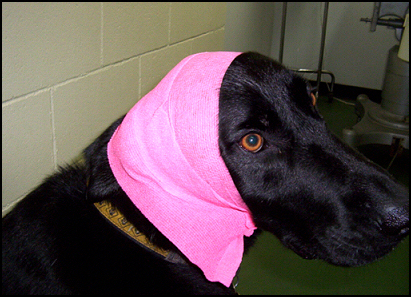How to Bandage Your Dog or Cat Correctly
![]()

Accidents happen, and when they do, it’s essential to know how to care for your pet’s wounds properly. Whether it’s a minor cut, scrape, or more serious injury, bandaging your dog or cat’s wounds is an important skill every pet owner should have. Not only does it protect the injury from infection, but it also helps promote faster healing. In this guide, I’ll walk you through the proper steps to bandage your pet’s wounds effectively, ensuring they’re comfortable and on the road to recovery.
Why Choose Dr. Jones’ Ultimate Canine Health Formula for Your Dog?

While you’re here, why not give your pet an extra boost to support their overall health? Dr. Jones’ Ultimate Canine Health Formula is the perfect addition to your dog’s routine. This all-natural, comprehensive formula supports mobility, joint comfort, and boosts energy levels, helping your dog stay active and playful. It’s the ideal way to promote long-term well-being, whether your dog is healing from an injury or simply living their everyday life.
Why Choose Dr. Jones’ Ultimate Feline for Your Cat?

For your cat, I also recommend Dr. Jones’ Ultimate Feline Health Formula, a holistic supplement designed to support digestive health, alleviate symptoms of aging, and improve overall vitality. Just like with dogs, it’s important to support your pet’s health from the inside out.
Read on to learn how to properly bandage your pet and discover how these natural supplements can keep them feeling their best.

Bandaging Your Pet’s Wounds: How to Do It Right
Pets, especially dogs and cats, seem to get their share of injuries. From scrapes to cuts, wounds are fairly common. One issue that I see regularly is lick granulomas—areas of the skin that your pet repeatedly licks, often causing irritation or even injury. Bandaging can be a helpful solution for these injuries, but it must be done correctly.
I recently saw a dog whose owner had applied a homemade bandage incorrectly. The bandage was too tight, and the poor dog’s foot had swollen to three times its normal size! So, if your pet ever needs a bandage, here’s how to do it properly.
Bandaging the Leg
The most common area to bandage is the leg. Here’s how to do it right:
-
Clean the wound properly – Make sure the area around the wound is clean before you begin.
-
Apply two strips of hospital tape – Place one strip on the inside and one on the outside of the leg. This will help secure the bandage.
-
Use a non-stick Telfa pad – Place the Telfa pad directly over the wound to prevent the bandage from sticking to it.
-
Wrap with gauze – Starting at the toes, wrap the leg with gauze, overlapping the layers as you go. Keep the toes exposed so you can check for swelling. The wrap should be firm enough to keep the pad in place but not too tight. Continue wrapping until you reach the next joint. If the wound is on the paw, extend the wrap above the wrist.
-
Cover with Vet Wrap or tape – Finally, secure the gauze with Vet Wrap or tape. Again, ensure it’s firm but not too tight, and leave the toes exposed.
Bandaging the Head
Sometimes, pets can injure areas like their ears, which might require a bandage. Here’s how I approach it:
-
Fold the earflaps – If your pet has an injured ear, fold the earflaps on top of their head.
-
Wrap with gauze and tape – Wrap gauze and tape around the head to hold the ears in place. Alternatively, pantyhose can be a great option because it stays in place much better than traditional bandages.
-
Adjust for comfort – Make sure the bandage is in front of the eyes and not too tight around the neck. You should be able to slip one finger underneath the bandage to make sure it’s not cutting off circulation.
Help your pet the right way!
Bandages can be incredibly effective, but only if applied correctly. Make sure the bandage isn’t too tight and that the wound is properly covered. Always check your pet’s bandage regularly to ensure it’s not causing any swelling or discomfort.
To learn more about how to heal your pet at home the right way, check out my book. It’s packed with helpful information, and if you act quickly, you can grab it before the price goes up!

Why Choose Dr. Jones’ Ultimate Canine Health Formula for Your Dog?
While you’re here, why not give your pet an extra boost to support their overall health? Dr. Jones’ Ultimate Canine Health Formula is the perfect addition to your dog’s routine. This all-natural, comprehensive formula supports mobility, joint comfort, and boosts energy levels, helping your dog stay active and playful. It’s the ideal way to promote long-term well-being, whether your dog is healing from an injury or simply living their everyday life.
Why Choose Dr. Jones’ Ultimate Feline for Your Cat?
For your cat, I also recommend Dr. Jones’ Ultimate Feline Health Formula, a holistic supplement designed to support digestive health, alleviate symptoms of aging, and improve overall vitality. Just like with dogs, it’s important to support your pet’s health from the inside out.

















How is it best to treat lick granulomas on a dog?
medicine it’s best?
We do have an article for you:
—– Lick Granuloma —–
This is a specific skin disorder in which a dog constantly licks one area of their body (typically the front wrist), producing a red, raised, thickened, infected area of skin.
It often occurs in dogs that are left alone, or have anxiety.
And they like to lick/chew.
Then because the area is irritated, they NEVER leave it alone.
—– So what can you do? —–
Well traditional treatment goes something like:
Antibiotics.
Steroids – topically and orally.
An E -collar to prevent licking.
… But what usually happens?
The lesion comes back when the medication runs out.
Alternative treatment on the other hand involves may options.
But 3 of the more effective ones are:
1. A Bitter Apple spray to deter the licking.
2. A tea/aspirin topical combination to dry out the area, and provide some relief.
3…. Here’s the BIG one… Acupressure.
It involves 4 easy to find acupressure points.